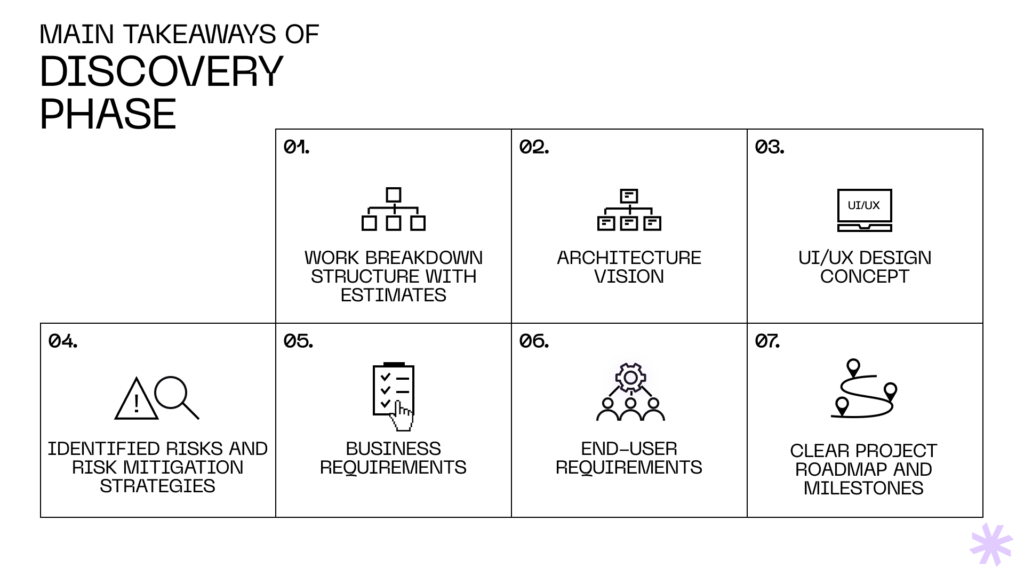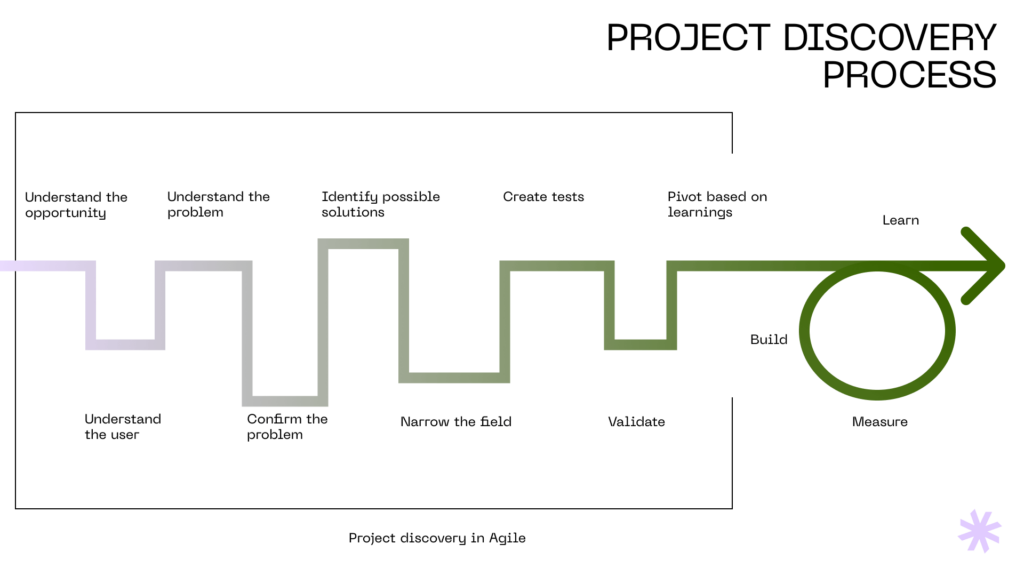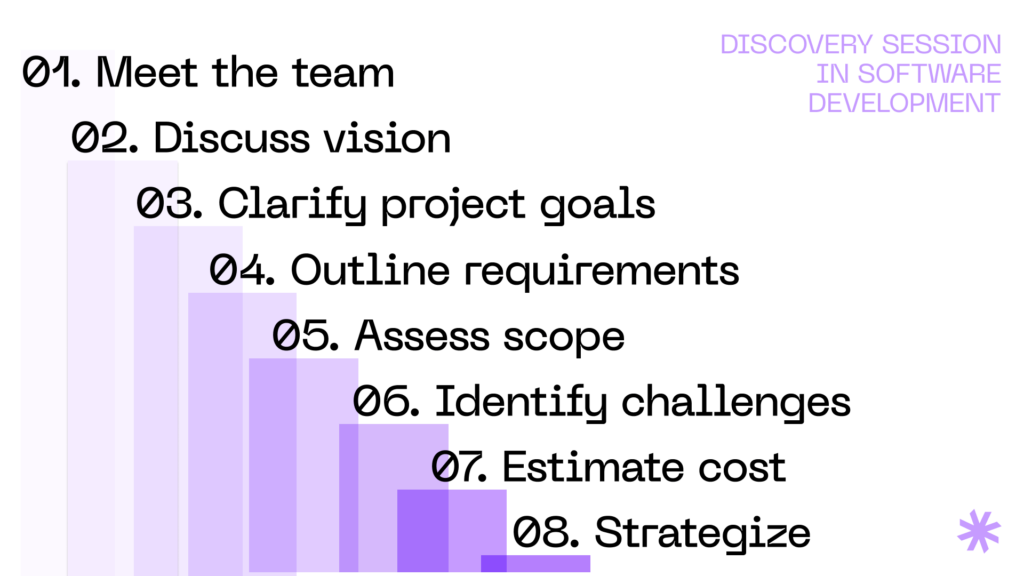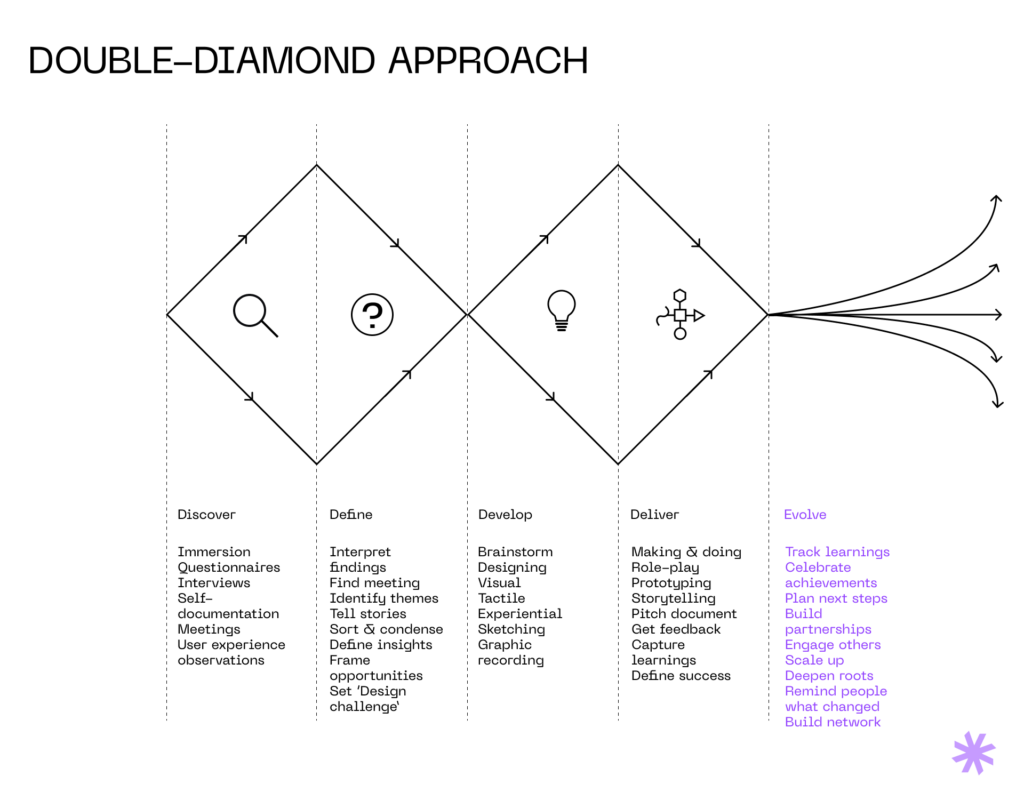According to McKinsey, only about 59% of projects are completed within budget, and the odds of delivering on time are even lower—just 47%. Not exactly comforting, right?
We agree. That’s why we dug into the research to understand what typically derails projects and developed a strategy to boost our success rate. Our approach has several layers, but one of its core pillars is a thorough discovery phase at the start of each project.
In this article, we’ll walk you through what a discovery session is, its goals, and how it helps keep projects on time and within budget. You’ll also get an overview of your role in this phase, along with tips on how to support the development team to make the process even smoother.
Let’s dive in!
What is a discovery session?
A discovery session is an initial, strategic meeting held at the beginning of a new custom software development project. It brings together the client and the development team to clarify project goals, requirements, target users, and potential technical challenges.
During this session, everyone aligns on what the project should achieve, who it’s for, and how to tackle it. By the end, the client and development team leave with a clear game plan for what lies ahead, from project scope to resource needs.
Discovery session vs. discovery phase: what’s the difference?
A discovery session is typically a one-time, focused meeting aimed at clarifying project essentials. It works well for small projects with clear objectives and a straightforward scope, allowing the team to set goals, confirm requirements, and create a project plan in a relatively short timeframe.
In contrast, a project discovery phase is a more in-depth process that can span days, weeks, or even months. This extended phase is essential for complex projects or those with uncertain requirements.
It gives the team time to conduct thorough business discovery and research, which may include user interviews, technical feasibility studies, competitor analysis, and prototyping.
For simplicity, we use “discovery session” and “discovery phase” interchangeably in this article, as they serve the same goals.

What is the goal of the discovery session?
The main goal of the software discovery process is to establish a solid foundation for the project by clarifying the key details early on. When the client and development team are on the same page from the start, the project can stay focused, avoid surprises, and deliver what’s expected.
This goal can be broken down into the following components:
Goal 1: Identify project scope
The team and client define what the project will cover—and what it won’t. Setting clear boundaries right from the start helps prevent misunderstandings and keeps everyone focused on the most important goals.
Goal 2: Specify requirements
It’s essential to get detailed about requirements. During the session, you’ll outline what’s needed for the features, integrations, and overall user experience. This way, the development team knows exactly what to deliver.
Goal 3: Outline potential challenges
A discovery session is also a chance to spot any potential roadblocks early. By discussing technical challenges or resource limits, the team can plan ahead, making it easier to navigate around issues that could slow down the project.
Why is a discovery session important?
A discovery session is a critical step beyond initial planning. It ensures that the client and development team have a shared understanding of the project’s goals and challenges.
By addressing key details upfront, the session helps set the stage for a smoother, more efficient development process.
1. Aligns vision and expectations
The IT discovery process brings everyone to the same page, ensuring the client’s vision matches what the team can deliver. By clarifying goals and expectations early, the team can avoid misunderstandings that might derail the project later.
2. Saves time and resources
Sorting out requirements and challenges upfront can save a lot of time and money. When the development team understands the full scope from the beginning, it reduces the need for rework, keeping the project on track and on budget.
3. Enhances collaboration
A successful discovery session builds a collaborative environment between the client and the development team. It fosters open communication, making it easier to tackle issues and align on decisions as the project progresses.
4. Helps set realistic timelines and budgets
By discussing resources, deadlines, and potential roadblocks, the team can set achievable timelines and budgets. This realistic planning helps prevent costly delays and gives clients a clear picture of what to expect.
Unsure where to start with your project?
A comprehensive discovery phase can uncover the insights you need to build with confidence. Reach out now to learn how our discovery services can clarify your vision, define requirements, and set a clear path forward!
Contact usProject discovery vs. product discovery – what’s the difference?
Project discovery and product discovery both aim to clarify objectives, but they focus on different outcomes. In project discovery, the emphasis is on defining the scope, budget, timeline, and technical requirements for a specific project.
It’s about laying out a clear path to complete a defined task within set parameters.
Product discovery, on the other hand, is broader and more exploratory. It focuses on understanding user needs, testing ideas, and refining concepts to build a product that truly resonates with users.
The software product discovery process is typically ongoing, helping shape the product vision and direction over time.

When do you need a discovery session?
A discovery session is valuable at various stages of software development, especially when there’s a need for clarity and alignment. Here are some key situations where discovery can make a huge difference:
Launching a new project
Starting a new project from scratch requires clear planning to set it up for success. A discovery phase helps define the project’s goals, target audience, and required features, ensuring that the team and a new client are aligned from the beginning.
When requirements aren’t fully defined
Sometimes, a project idea is in place, but the details aren’t fully fleshed out. A discovery session allows the client and team to clarify requirements, prioritize features, and address uncertainties, preventing costly adjustments later.
Scaling a software product
After MVP development is complete and validated or when scaling a product, discovery helps identify improvement areas, assess technical needs, and ensure a seamless user experience. This proactive planning keeps growth efficient and on track and minimizes disruptions as the product evolves.
When can you skip a discovery meeting?
While a discovery session is often essential, there are cases where you can move forward without it. Here are some situations where a discovery process may not be necessary:
Straightforward project with clear specifications
If the project goals, requirements, and specifications are fully defined and straightforward, you might not need a discovery session. When everyone knows exactly what needs to be done, the team can jump right into development with minimal risk of misalignment.
Proven solutions or templates
When using an established solution or template that’s been tested and customized before, a discovery session might be overkill. For these projects, you can often rely on pre-built frameworks or processes, which already cover common requirements.
Quick Proof of Concept (PoC) or prototype
A discovery meeting may not be necessary for a fast PoC or prototype to test an idea. Since the goal here is to validate a concept quickly, it’s often more effective to dive in, experiment, and refine based on early feedback.
Not sure if you need a discovery process?
Let’s discuss your project’s needs and find the right approach to bring your vision to life. Get in touch today!
Write usWhat to expect during your discovery session
A project discovery phase typically follows a structured agenda to cover all crucial aspects of the project. It’s an open, collaborative meeting where the team and client discuss goals, priorities, and potential challenges.

While every company decides how to run a discovery session in its own way, key questions focus on what the client wants to achieve, who the target users are, and any limitations to keep in mind. Here’s a breakdown of the typical steps in the discovery process:
1. Team introductions
The session usually includes project stakeholders from both the client’s and development team’s sides. Common participants are the project manager, product owner, developers, designers, and sometimes marketing or sales reps. This introduction helps everyone understand each other’s roles and builds a foundation for collaboration.
- Deliverable: Roles and Responsibilities Document
After introductions, you’ll receive a document clearly outlining each participant’s role and responsibilities. This serves as a guide to who will handle specific tasks and make decisions, fostering smooth teamwork from the start.
2. Deep dive into the project goals and vision
The team will guide a conversation about the project’s big-picture goals and the vision you have for the product. This step is essential for ensuring everyone has a shared understanding of what the final product should accomplish and its intended impact.
- Deliverable: Project Vision and Objectives Summary
A concise document outlining the project’s overarching goals, vision, and expected impact. This serves as a reference point, ensuring everyone is aligned on the project’s core purpose and outcomes.
3. Clarifying requirements and scope
Next, the team helps you break down specific requirements for features, integrations, and user interactions. Together, you’ll answer some technical discovery questions and define the project’s boundaries—what’s included and what’s not—to keep the development focused and manageable.
- Deliverable: Requirements and Scope Document
This document details all essential features, functionalities, and integrations. It also defines the project scope clearly, outlining inclusions and exclusions to prevent scope creep.
4. Identifying challenges and constraints
The team works with you to spot any potential roadblocks, such as technical limitations, budget restrictions, or regulatory requirements. Addressing these early on can help prevent issues from cropping up later.
- Deliverable: Risk Assessment Report
A list of potential technical, budgetary, and regulatory challenges, along with strategies to address each one. This prepares the team to manage risks effectively from the beginning.
5. Timeline and budget planning
Together, you’ll set realistic expectations about the project’s duration and cost. The team will offer guidance on timelines and budget estimates based on the scope and requirements discussed so you have a clear roadmap to move forward.
While you may have a rough estimate from earlier discussions, this session refines those numbers. Unlike the initial ballpark estimate—which is often broad and based on limited information—the estimate from the discovery phase is far more accurate.
- Deliverable: Initial Timeline and Budget Estimate
A preliminary roadmap and budget breakdown based on the requirements and scope discussed. This estimate gives you a realistic view of the project’s timeline and costs, helping you plan resources and manage expectations.
6. Strategic insights and recommendations
To wrap up, the team may provide strategic recommendations on the best approach to meet your project goals. These insights can help guide the project’s direction and ensure a successful path forward as development begins.
Ready to turn your vision into a solid plan?
Start with a discovery session to gain clarity, define goals, and build a roadmap for success. Contact us today to schedule your session and set your project up for a seamless start!
Contact usHow to prepare for the discovery process?
Preparing for a discovery meeting helps ensure the process is efficient and productive. A bit of groundwork can make a big difference, helping you communicate your vision clearly and get the answers you need. Here’s how to make the most of your discovery process as a client:
1. Bring background information
Gather any relevant documents, such as previous project plans, user research, competitor analysis, or product specs. This background information gives the team a head start and provides valuable context, helping them understand your vision and specific needs right from the start.
2. Prepare questions and concerns
Write down any questions or concerns you have about the project. These might include clarifying timelines, asking about technical feasibility, or understanding the development process. Here are some example discovery session questions:
- “What challenges do you anticipate for this project?”
- “How will you ensure the project stays on budget and schedule?”
- “What will the communication process look like?”
- “How do you approach changes in project scope if new needs arise?”
3. Be open to ideas
A discovery session is about exploring the best solutions for your project, so it’s helpful to stay open-minded. The team may present new approaches, suggest different features, or highlight potential improvements you hadn’t considered. Embracing fresh perspectives can lead to a stronger final product and a smoother project journey.
Post-discovery session – what are the next steps?
After discovery, the insights gathered become the foundation for your project’s development roadmap. The team will use the defined goals, requirements, and identified challenges to outline the development phases, timelines, and resource allocation.
With a clear scope and prioritized features, this roadmap provides a structured approach to achieving your vision step by step.
You’ll receive a comprehensive report summarizing all findings, including the finalized project requirements, technical recommendations, and a realistic timeline and budget.
This is also the stage where you can refine and adjust elements based on what was discussed during the process of discovery. Whether it’s tweaking features or reassessing priorities, you’ll have the flexibility to ensure the plan fully aligns with your vision.
Once the roadmap is agreed upon, the team will initiate the development process, ensuring that each phase is carefully managed to deliver a high-quality product that meets your goals.

Wrapping up: Set your project on the path to success
At Syndicode, we use the software discovery process to thoroughly understand your vision and goals, identify risks early, and create a roadmap that’s both achievable and aligned with your budget.
Our structured, multi-tiered strategy combines expert planning with agile discovery phase project management to keep everything on track from start to finish.
Whether launching a new project, scaling an existing product, or testing a proof of concept, our team is here to guide you every step of the way, ensuring that your project meets your expectations and delivers real value. Contact us today to get started!
Frequently Asked Questions
-
What are the benefits of a discovery session for an entrepreneur?
For entrepreneurs, a discovery session is invaluable because it provides clarity, direction, and a foundation for the project. This session allows you to work closely with the development team to outline your vision, define requirements, and align expectations. By identifying project goals and potential challenges early, discovery helps prevent costly adjustments later on. This process also empowers you to make more informed decisions about timelines and budgets, ensuring that you allocate resources effectively. Ultimately, it’s a proactive step that increases the likelihood of delivering a product that meets user needs and supports your business objectives.
-
How long does the software discovery process take?
The duration of a discovery session in software development depends largely on the project’s complexity. For simpler projects, the process of discovery might require just one initial meeting, followed by a few days for the team to process the information and create a project roadmap. However, for more complex projects with multiple requirements, the discovery phase can span several weeks. Every technical team decides how to conduct a discovery session in its own way, but, typically, this phase includes a series of workshops, in-depth discussions, and research activities. They allow the team to explore business goals, technical requirements, and user needs thoroughly. Although it takes time upfront, a thorough discovery phase streamlines development by providing a clear, well-structured roadmap—ultimately saving both time and resources.
-
How much does the discovery phase cost?
The cost of a discovery phase varies based on the project’s scope, complexity, and required level of detail. At Syndicode, this phase typically accounts for 5-10% of the total project cost. While this initial investment may seem significant, it often leads to substantial savings by preventing scope creep, unnecessary features, and expensive revisions later in development.
-
Will I receive any documentation or summary after the discovery session?
Yes, at the end of a discovery process, you’ll receive a comprehensive summary document covering all key findings. This includes insights, defined goals, project scope, user requirements, identified risks, and a high-level development roadmap. This document serves as both a project tracking tool and a foundation for future scaling, helping keep everything focused. It’s also an easy reference point if adjustments are needed later, ensuring everyone stays aligned as the project moves forward.
-
Do I always need a discovery session before starting a project?
Not necessarily. While a discovery session is highly recommended for complex or larger projects, smaller or well-defined projects may not require one. If you have clear specifications, a straightforward project scope, and limited customization needs, a full discovery session might not be necessary. In these cases, a quick initial consultation may be enough to establish project basics and move directly into development. However, if there’s any uncertainty about requirements, target audience, or technical feasibility, discovery can clarify these elements, reduce risks, and set a strong foundation for success.
-
What if I have more questions or changes after the discovery session?
If new questions or changes arise after the discovery session agenda is completed, your development team will work with you to address them. It’s common for evolving insights or market shifts to impact project direction, and most teams build flexibility into their process to adapt to changes. Small adjustments may be managed within the existing roadmap, while significant changes may require an additional refinement session. Open communication is key, so don’t hesitate to reach out. Our team is there to help you refine ideas, answer product discovery questions, and keep the project aligned with your evolving vision and goals.
